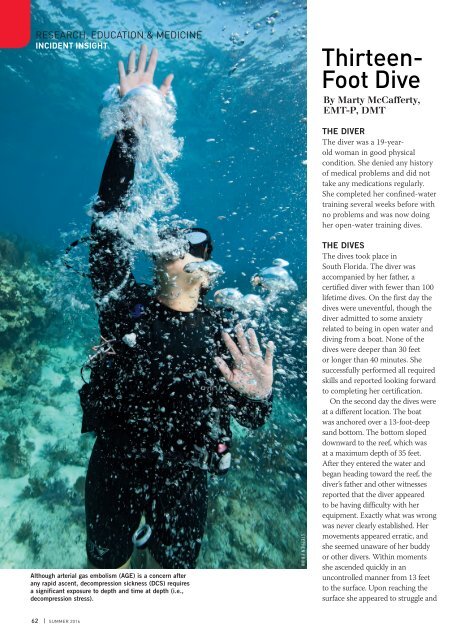AD 2016 Q3
Alert Diver is the dive industry’s leading publication. Featuring DAN’s core content of dive safety, research, education and medical information, each issue is a must-read reference, archived and shared by passionate scuba enthusiasts. In addition, Alert Diver showcases fascinating dive destinations and marine environmental topics through images from the world’s greatest underwater photographers and stories from the most experienced and eloquent dive journalists in the business.
Alert Diver is the dive industry’s leading publication. Featuring DAN’s core content of dive safety, research, education and medical information, each issue is a must-read reference, archived and shared by passionate scuba enthusiasts. In addition, Alert Diver showcases fascinating dive destinations and marine environmental topics through images from the world’s greatest underwater photographers and stories from the most experienced and eloquent dive journalists in the business.
You also want an ePaper? Increase the reach of your titles
YUMPU automatically turns print PDFs into web optimized ePapers that Google loves.
RESEARCH, EDUCATION & MEDICINE<br />
INCIDENT INSIGHT<br />
Thirteen-<br />
Foot Dive<br />
By Marty McCafferty,<br />
EMT-P, DMT<br />
Although arterial gas embolism (AGE) is a concern after<br />
any rapid ascent, decompression sickness (DCS) requires<br />
a significant exposure to depth and time at depth (i.e.,<br />
decompression stress).<br />
STEPHEN FRINK<br />
THE DIVER<br />
The diver was a 19-yearold<br />
woman in good physical<br />
condition. She denied any history<br />
of medical problems and did not<br />
take any medications regularly.<br />
She completed her confined-water<br />
training several weeks before with<br />
no problems and was now doing<br />
her open-water training dives.<br />
THE DIVES<br />
The dives took place in<br />
South Florida. The diver was<br />
accompanied by her father, a<br />
certified diver with fewer than 100<br />
lifetime dives. On the first day the<br />
dives were uneventful, though the<br />
diver admitted to some anxiety<br />
related to being in open water and<br />
diving from a boat. None of the<br />
dives were deeper than 30 feet<br />
or longer than 40 minutes. She<br />
successfully performed all required<br />
skills and reported looking forward<br />
to completing her certification.<br />
On the second day the dives were<br />
at a different location. The boat<br />
was anchored over a 13-foot-deep<br />
sand bottom. The bottom sloped<br />
downward to the reef, which was<br />
at a maximum depth of 35 feet.<br />
After they entered the water and<br />
began heading toward the reef, the<br />
diver’s father and other witnesses<br />
reported that the diver appeared<br />
to be having difficulty with her<br />
equipment. Exactly what was wrong<br />
was never clearly established. Her<br />
movements appeared erratic, and<br />
she seemed unaware of her buddy<br />
or other divers. Within moments<br />
she ascended quickly in an<br />
uncontrolled manner from 13 feet<br />
to the surface. Upon reaching the<br />
surface she appeared to struggle and<br />
62 | SUMMER <strong>2016</strong>









